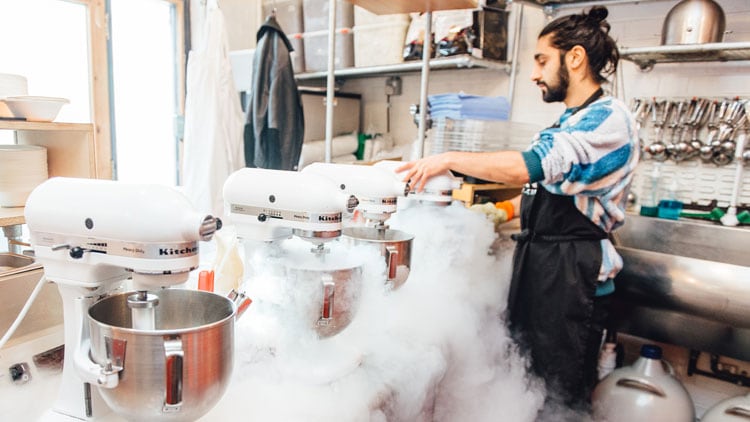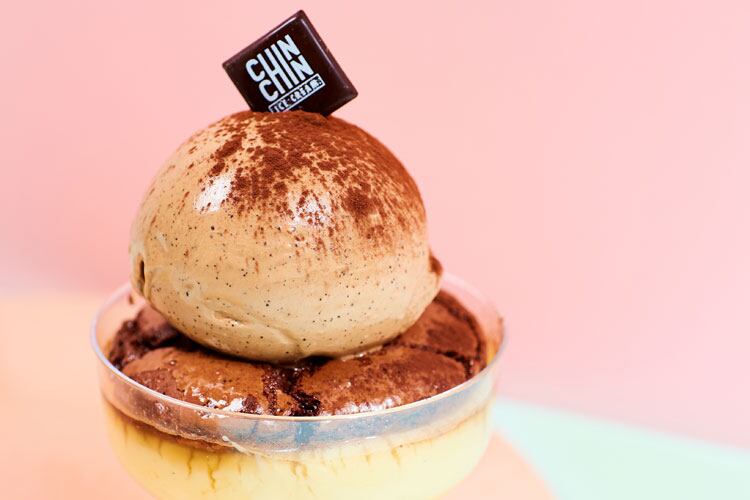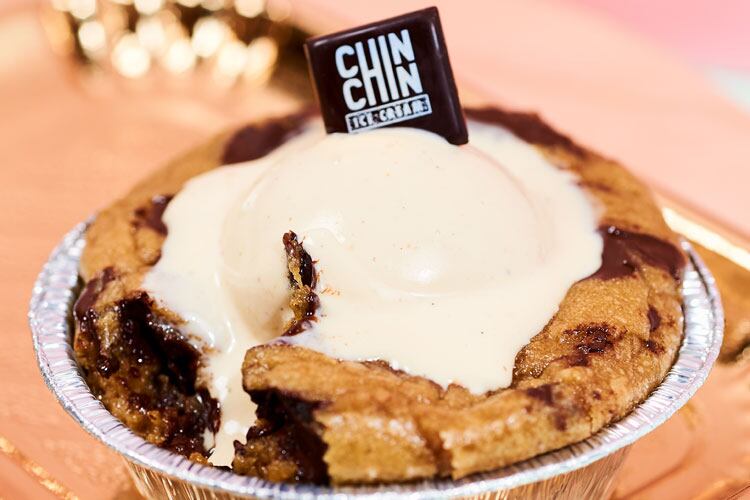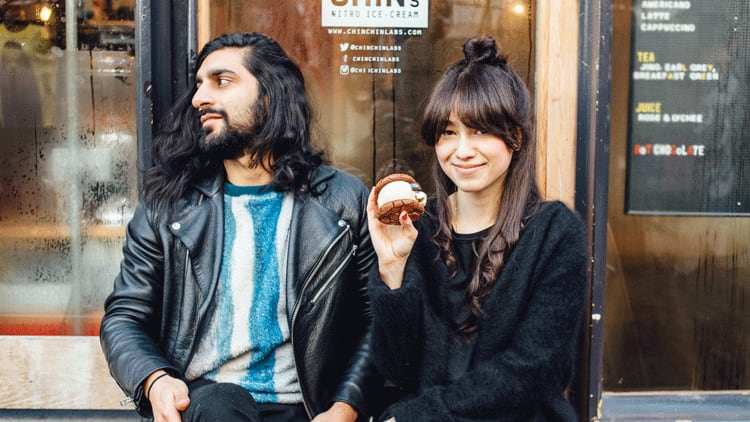In Chin Chin’s Soho café a member of staff moves behind a glass screen, donning a mask and gloves before pouring a canister of billowing liquid nitrogen into a mixer with an ice cream base. It’s a performance that evokes both Willy Wonka and Walter White, but is about more than just theatrics.
Flash freezing at -196 degrees creates a smoother ice cream with smaller crystals, and the result is a velvety texture, like eating cold butter. Combined with Chin Chin’s experimental flavours and toppings, which have in the past included mango lassi and black tahini, the desserts have become an Instagram hit and helped the fledgling group grow to three sites in Camden, Soho and at Dinerama in Shoreditch.
“Luckily our customers are open-minded; we’re not serving a typical Mr Whippy,” says co-owner Ahrash Akbari-Kalhur. “We take a scientific approach to ice cream, everything we make has to be unique.”

Perfecting a tough sell
Selling ice cream in the UK can be a tough gig. London’s gloomy climate may not seem like the ideal place for a cold dessert bar, but Chin Chin, the brand Akbari-Kalhur founded with his wife Nyisha Weber in 2010, offers more than just a 99 with a flake.
Chin Chin had a tricky start. The idea was born out of the recession, a ‘pie in the sky’ plan the couple took seriously after leaving their jobs in 2009.A former lawyer, Akbari-Kalhur retrained as a pastry chef and was inspired by the molecular gastronomy movement (Ferran Adria’s El Bulli in Spain was serving liquid nitrogen ice cream tableside). “We saw the reactions it got, but that was a 500-euro meal,” he says. “Our idea was to make that more accessible and affordable.”
The couple initially had to recipe-test using dry ice (the solid form of carbon dioxide), before convincing a supplier that provided liquid nitrogen to medical clinics on London’s Harley Street to give them a chance.
After some ‘serious’ training, the pair managed to secure Chin Chin’s first small shop in Camden in 2010. Decorated with glass beakers, pipettes and a huge tank of liquid nitrogen, it looked more like a science lab than an ice cream parlour.
There was no investor, crowdfunding or real business plan, instead Akbari-Kalhur describes it as a ‘passion project’. “The landlord was open-minded and gave us a shot, whereas most people we spoke to were sceptical about having 300 litres of liquid nitrogen on site,” he says.
The first few years in Camden were a struggle. Pre-Instagram customers were slower to embrace Chin Chin’s experimental approach, which saw custard bases flash frozen to order amid billows of vapour, and initially around 60% of all sales were vanilla. “But people got drawn in by the theatrics, and once they tasted the product we started to get regulars and then queues,” says Akbari-Kalhur.
After taking up a spot at Dinerama in Shoreditch the team opened Chin Chin in Soho in 2017, branching out from ice cream to creative cakes and desserts such as banana jam pie topped with blowtorched sugar, and a brownie cookie sandwich. Three chefs now work in the downstairs kitchen to help come up with new items for the constantly changing menu.
A scientific approach to flavours
The team still take cues from high-end restaurants but is also academic in its approach. “Creating ice cream is like following a formula. Once you get your fat and sugar and ratios right, it’s relatively simple,” says Akbari-Kalhur.
“If we make a cherry ice cream, we’ll look at the flavour profiles and try to match pairings based on what the compounds are in a cherry. Almonds are closely related, so it makes sense to put the two together.”
Current flavours include yuzu piña colada, coffee and olive oil, and pandan leaf (which has a taste often likened to birthday cake). The most popular now is burnt butter caramel, which accounts for 55% of all sales. The team is currently on its 19th trial to create brioche waffles, and Akbari-Kalhur says finding the perfect pastry for a cherry pie took around three and a half months.
Prices are kept around the £5 mark, while optional toppings such as heather honeycomb, cinnamon toast and truffle crumble come in at an extra 55p. “We put margins aside and do what we want. There’s only so much you can charge for ice cream.”
The menu also changes with the seasons to weather London’s gloomy climate (its ice cream sales are around 50% less between October and April than in the summer months), with the desserts playing a more pivotal role when the mercury drops. “Luckily now people eat a lot of hot desserts with a scoop of ice cream in winter. You’ve got to adapt constantly but that keeps it fun.”
Chin Chin also owes a lot to the rise of Instagram, which has made the small brand visible to a global audience. In 2016 a video of its hot chocolate overflowing with marshmallow posted by blogger @notsobasiclondon went viral, amassing more than 20 million views and saw queues outside the Camden store in chilly January. Akbari-Kalhur says the value of Instagram has surpassed that of traditional advertising or national press.
“We have a huge following in the Gulf. A lot of prominent bloggers in the Middle East have posted about us so we get families coming from Dubai and Saudi Arabia. It’s a big percentage of our customer base, which is wild. But it means we don’t have to rely on Londoners.”
The impact has been so huge that it’s even affected how Chin Chin produces its ice cream in order to appease the snap-happy generation. “Now we have to take into account that someone will want to take a picture before they eat it, so it means we have to freeze it firmer. That’s the power of Instagram.”

Such creativity has attracted the attention of big players in the ice cream industry. Last year Akbari-Kalhur posted on Instagram that he had to kick out of the shop a group who admitted to working for consumer goods giant Unilever – which owns brands including Ben & Jerry’s, Wall’s and Magnum – when staff found them making notes. He says there have been similar incidents with other well-known names.
“On one hand it’s flattering, but it means that we have to constantly innovate to out-run everyone behind us. The big companies have massive amounts of researchers and funds we don’t have. Ultimately, everyone in the food industry looks at their competitors, but it’s frustrating when they bring their clipboards out and start asking to see the kitchen. We still have the creativity within us, and they can’t take that.”
The future is vegan
Going forward, Chin Chin’s focus has pivoted to the vegan market, and the majority of its menu development is now on plant-based items. The chefs make use of coconut, soy and rice milk, as well as the natural fattiness of nut butters. The velvety texture given to ice cream by flash freezing with liquid nitrogen means it is easier to create a creamier taste without egg or heavy dairy products.
“You have to move with the times,” says Akbari-Kalhur. “Plant-based ice cream is probably the future. There are lots of tricks with fruits – you can make a really smooth and creamy pineapple ice cream just by processing it differently.”
Despite its success, Chin Chin has so far been cautious about expansion. Its Soho café currently acts as a central kitchen for its sites in Camden and Shoreditch, creating all the toppings and some of the ice cream bases before they are driven over each morning, and the team believes this model could work for future sites. The company is also looking into producing its own liquid nitrogen as a way of becoming more self-sufficient.

“We like the idea of having a small chain of kiosk-style shops, but every site has to be different, or what’s the point? It’s not enough to expect people to go to cookie-cutter shops anymore.”
The team is also looking abroad to sunnier climes and is hoping to capitalise on its huge following in the Gulf. There is talk of looking for the right partner in the region, but Akbari-Kalhur is adamant expansion will remain under his control. He and Weber are protective of their vision, and have no desire to see the quality drop.
“It’s no good trying to make the best ice cream with liquid nitrogen if your cookies are stale or you’re using long life milk to save money. It might look great for the ’gram but it’s the flavour that will bring people back, not the look of the store or how many flowers you have above your shop front. We like to steer clear of trends and try to make our own way. The liquid nitrogen can only get you so far.”
Generation Next is a club for the rising stars in hospitality. For information on how to join or the next club events, contact jo.wattar@wrbm.com

This is a web version of an article that first appeared in the September issue of Restaurant magazine, the leading title for the UK's restaurant industry. For more features, comment, interviews and in-depth analysis of the restaurant sector subscribe to Restaurant magazine here.

